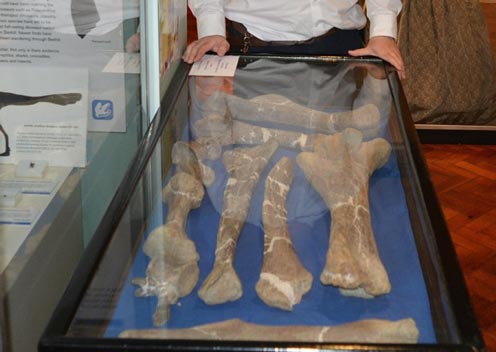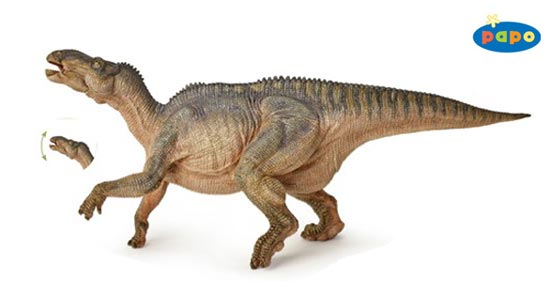Hypselospinus Dinosaur Fossils on Display at Bexhill Museum
The fossils of a large, plant-eating dinosaur have gone on display at Bexhill Museum (East Sussex). The dinosaur is a type of iguanodontid dinosaur, part of a clade of very successful bird-hipped dinosaurs that were very geographically widespread during the Mesozoic Era. The fossils, which represent limb bones and a single tail bone (caudal vertebra), were discovered by local palaeontologists Peter and Joyce Austen, it was Joyce, a specialist in palaeobotany, who found the first evidence of this dinosaur’s remains although the majority of the bones were excavated by local fossil hunter and dinosaur enthusiast David Brockhurst.
Hypselospinus Dinosaur Fossils
The Hypselospinus Fossils on Display at Bexhill Museum
Picture credit: Bexhill-on-Sea Observer
Iguanodon Dinosaur – Hypselospinus fittoni
The dinosaur (Hypselospinus fittoni), was formerly named and described in the late 19th Century, from other fossil material found in East Sussex. The Bexhill Museum material has been dated to the Early Cretaceous geological period. A spokesperson from Everything Dinosaur explained that during the Early Cretaceous much of southern England formed a verdant flood plain that teemed with prehistoric life. The Hypselospinus fossils are estimated to be around 14o million years old.
Bexhill Museum is an independent museum run by volunteers whose patron is the comedian Eddie Izzard. It contains a wide variety of artefacts including a number of locally sourced fossils including dinosaurs and flying reptiles (pterosaurs). For the residents of this East Sussex seaside resort, it might be difficult to comprehend but back in the Early Cretaceous dinosaurs roamed the area.
A Model of a Typical Iguanodontid Like Hypselospinus
Picture credit: Everything Dinosaur
Named and Described in 1889
Hypselospinus was formally named and described in 1889. It was typical of an iguanodontid dinosaur, reaching lengths of around six metres and perhaps weighing as much as two tonnes. It ambled around on all fours, but if the need arose, it could rise up onto its strong hind legs and adopt bipedal locomotion. Large neural spines associated with the dorsal vertebrae (back bones) suggest that Hypselospinus had a steeply arching back, this feature distinguishes this dinosaur from other iguanodontids known from southern England. It was formerly known as Iguanodon fittoni.
Everything Dinosaur supplies a range of museum quality, hand-painted dinosaur models including replicas of iguanodontids and the Papo Iguanodon dinosaur model. These are ideal for use in schools and teaching programmes.
To view the model: Papo Dinosaur Models.



